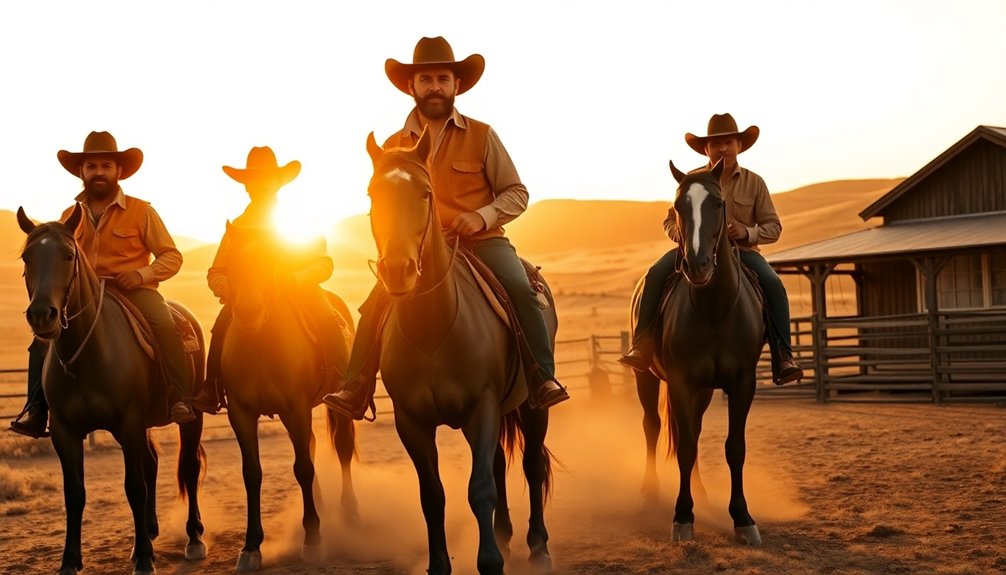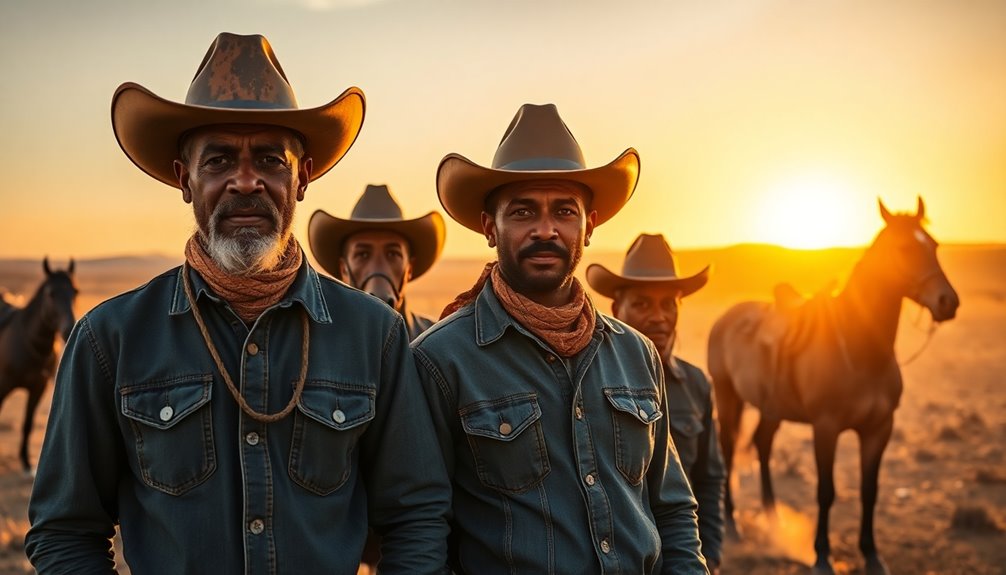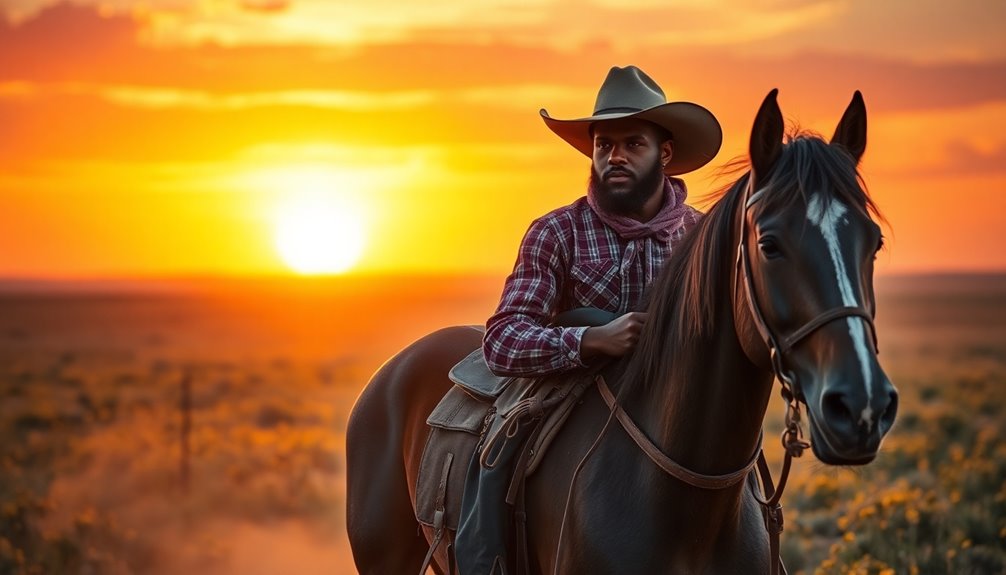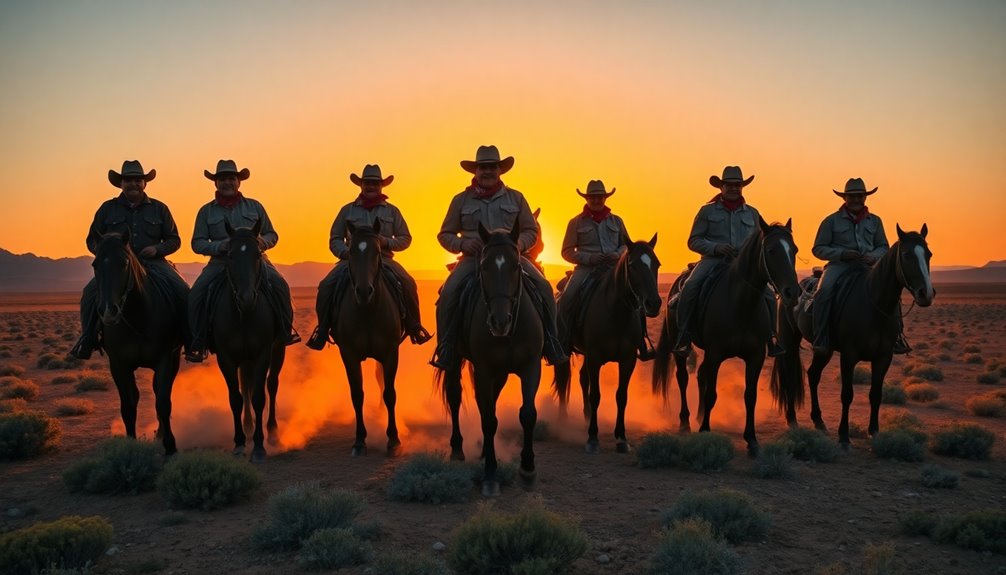Black cowboys played an essential role in shaping America's cattle culture, often overlooked in history. After the Civil War, many freed slaves migrated west, bringing valuable skills from their past. One in four cowboys involved in cattle drives was Black, showcasing their significant contributions. Notable figures like Nat Love and Bill Pickett transformed rodeo sports, while Bass Reeves broke barriers as one of the first Black U.S. marshals. Today, their legacy thrives in rodeo circuits and educational programs, challenging stereotypes and enriching our understanding of cowboy culture. You'll uncover even more exciting stories of these unsung heroes!
Key Takeaways
- Black cowboys played a crucial role in the cattle industry, with one in four cowboys involved in cattle drives being Black.
- Historical figures like Nat Love and Bill Pickett showcased resilience and innovation, shaping cowboy culture through their contributions.
- Post-Civil War, freed slaves migrated West, leveraging livestock handling skills from their past to thrive as cowboys.
- Modern Black cowboy traditions are celebrated in rodeos and cultural events, preserving their rich heritage and stories.
- Exhibitions like "Black Cowboys: An American Story" highlight the impactful narratives often overlooked in American history.
Witte Museum Exhibition Overview
The Witte Museum's exhibition "Black Cowboys: An American Story" celebrates the often-overlooked contributions of Black individuals to cowboy culture and the cattle industry. This exhibition dives deep into Texas history, revealing how essential Black cowboys were to cattle drives—one in four cowboys was Black.
You'll discover their impactful roles throughout history, spanning from pre-Civil War times to the 20th century. Curated by Ronald Davis, the exhibition features engaging elements like photographs, stories, and hands-on experiences with cowboy artifacts.
These interactive components attract thousands of families and schoolchildren, allowing them to actively engage with the narratives of Black cowboys. It highlights not just the stories of men, but also acknowledges the unique contributions of Black women in this sphere.
The exhibition aims to correct historical oversights, fostering awareness and community involvement regarding African American history. By showcasing these contributions, it promotes inclusivity and a richer understanding of Texas history. The exhibition also serves as a platform for dialogue, encouraging visitors to reflect on the ongoing impact of these historical narratives in today’s society. Additionally, it features resources that highlight various programs and initiatives, such as AARP benefits for seniors explained, which aim to support older adults in the community. By integrating educational elements with historical artifacts, the exhibition not only celebrates achievements but also promotes a sense of belonging among diverse audiences.
As you explore, you'll appreciate the grit and glory of Black cowboys, who've shaped the very fabric of cowboy culture in America.
Historical Context of Black Cowboys

As you explore the exhibition, understanding the historical context of Black cowboys enriches the experience. After the Civil War, many freed slaves migrated west, and Black cowboys played a significant role in the booming cattle industry.
It's estimated that one in four cowboys involved in cattle drives was Black, highlighting their important contributions to this essential economic activity in American history.
Many of these cowboys had prior livestock handling skills from their experiences on plantations, making them highly skilled in cattle driving and ranching. Their expertise was critical during the dangerous cattle drives from Texas to Kansas railheads, where the rugged landscape and unpredictable weather posed constant challenges.
Figures like Nat Love, known as Deadwood Dick, are part of the untold stories of Black history, revealing the adventurous lives of these individuals.
The shift from enslaved people to cowboys marked a significant evolution in the representation of Black Americans on the Western frontier. This transformation emphasizes not only their resilience but also their integral role in shaping the narrative of American history, showcasing their grit and glory in a landscape often overlooked. Additionally, the legacy of Black cowboys can be seen in the historic farmhouses that reflect the diverse cultural influences in rural America.
Contributions of Notable Figures

Notable figures among Black cowboys made significant contributions that shaped both the cattle industry and American culture. One such figure, Nat Love—better known as Deadwood Dick—chronicled his thrilling adventures in his autobiography, showcasing the skills and resilience of Black cowboys. His tales highlight the fundamental role these cowboys played in the history of Black contributions to the cattle industry.
Another notable figure, Bill Pickett, invented the rodeo technique of bulldogging, changing the landscape of rodeo sports forever. His innovation not only enhanced the sport but also solidified his status as a legendary performer in rodeo history.
Additionally, Bass Reeves emerged as one of the first Black deputy U.S. marshals, capturing outlaws and exemplifying the law enforcement contributions of Black cowboys to the American West.
Notably, one in four cowboys involved in cattle drives was Black, underscoring their crucial role in American agricultural history.
Today, their legacy is honored in dedicated museums, like the National Multicultural Western Heritage Museum, which celebrates the contributions of Black cowboys and guarantees their stories remain a significant part of American history.
Impact on Modern Culture

Black cowboys have a vibrant presence in modern culture, with their traditions celebrated and revitalized through rodeo circuits and community events across places like Texas. Their influence extends beyond rodeos, challenging traditional narratives and promoting inclusivity in the portrayal of the American West. You'll see how contemporary Black cowboys and cowgirls maintain cultural connections to their ancestors, passing down essential ranching knowledge and rodeo skills.
| Aspect | Example | Impact on Culture |
|---|---|---|
| Events | Witte Museum exhibition | Connects history with tradition |
| Influence in Media | Music, art, literature | Enriches popular culture |
| Educational Programs | Western Heritage Museum | Preserves and shares their stories |
These events and initiatives highlight the significant roles Black cowboys played in shaping Western heritage. They've left a lasting mark on popular culture, inspiring artists and musicians alike. By celebrating their contributions, you not only recognize their history but also enrich the narrative of the American West, ensuring the legacy of Black cowboys continues to thrive today and in the future.
Celebrating the Legacy

Celebrating the legacy of Black cowboys enriches our understanding of American history and culture. The Witte Museum's exhibition, "Black Cowboys: An American Story," highlights the significant contributions made by Black cowboys, revealing that one in four cowboys involved in cattle drives was Black. These individuals played an essential role in the cattle industry, drawing on their livestock handling skills honed on plantations to drive cattle from Texas to Kansas railheads.
This exhibition emphasizes the untold narratives of both free and enslaved Black individuals on Texas ranches, showcasing their resilience and cultural heritage from the pre-Civil War era to the early 20th century. Scholars like Ron Davis and Dr. Dinah Raymie Berry have shed light on the intersection of slavery, gender, and Black history within cowboy culture, further enriching our understanding.
Through ongoing recognition in museums and cultural events, the legacy of Black cowboys is preserved and celebrated, challenging traditional stereotypes.
Frequently Asked Questions
Were the First Cowboys Black or Mexican?
You'll find that both Black and Mexican individuals played essential roles in early cowboy culture. Mexican vaqueros laid foundational practices, while Black cowboys emerged considerably after the Civil War, shaping the rich tapestry of cowboy history.
Who Is the Most Famous Black Cowboy?
You might think of cowboys as all the same, but one stands out—Nat Love. Known as Deadwood Dick, he carved his legacy through daring adventures, rodeo victories, and an unforgettable autobiography that changed perceptions.
What Ethnicity Were Most Cowboys?
Most cowboys were white, but many Black, Hispanic, and Native American cowboys played essential roles in the cattle industry. Their diverse backgrounds enriched cowboy culture, showcasing a broader tapestry of contributions than commonly recognized.
What Is the TV Series About the Black Cowboys?
You might think cowboys were all white, but the TV series dives into the significant roles of Black cowboys, showcasing their contributions, resilience, and cultural heritage in the cattle industry and rodeo history.
Conclusion
As you walk away from the Witte Museum, let the spirit of these black cowboys ride alongside you, their stories echoing like the distant call of a lonesome whistle. You've glimpsed the grit and glory that shaped the American West, and now it's your turn to carry their legacy forward. Embrace their courage, share their tales, and watch as the past intertwines with the present, creating a tapestry of resilience that inspires us all.









